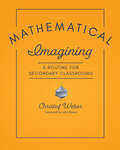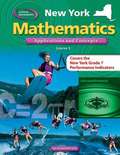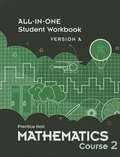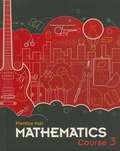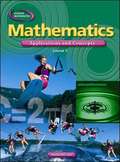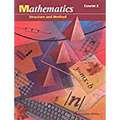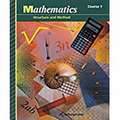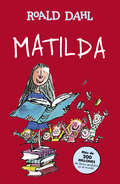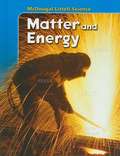- Table View
- List View
Mathematical Imagining: A Routine for Secondary Classrooms
by Christof WeberImagine a plastic cup lying on the floor. Give the cup a nudge so that it begins to roll. What does the path it takes look like? So begins the journey that Christof Weber takes you on in Mathematical Imagining: A Routine for Secondary Classrooms . Along the way, he makes the case that the ability to imagine, manipulate, and explain mathematical images and situations is fundamental to all mathematics and particularly important to higher level study. Most importantly, drawing on years of experiments in his own classroom, Weber shows that mathematical imagining is a skill that can be taught efficiently and effectively. Mathematical Imagining describes an original routine that gives students space and time to imagine a mathematical situation and then revise, discuss, and act upon the mental images they create. You can use this creative routine to glimpse into your students' thinking and discover teaching opportunities, while empowering them to create their own mathematics.Inside you’ll find the following: An introduction to the routine including the rationale behind it, facilitation guidance, and classroom examples Modifications to implement the routine in your classroom, even with varying time constraints 37 exercises broken into four categories: constructions, problem-solving, reasoning, and paradoxes Discussions of the mathematics involved in each exercise, including possible follow-up questions Instructions on how to create your own exercises beyond the book This one-of-a-kind resource is for secondary teachers looking to inspire student creativity and curiosity, deepen their own subject matter knowledge and pedagogical content knowledge, and invite all students to access the power of their own mathematical imaginations.
Mathematics 3, Florida
by Glenda Lappan James T. Fey William M. Fitzgerald Susan N. Friel Elizabeth Difanis PhillipsNIMAC-sourced textbook
Mathematics Application and Concepts: Course 3 (New York Edition)
by McGraw-HillYour textbook also gives you many opportunities to master the Mathematics Performance Indicators. Take time each day to do at least one sample problem either from the Countdown or from the lesson you are studying.
Mathematics Course 2 All-In-one Student Workbook Version A
by Prentice HallCourse 2 consists of a structured approach to a variety of topics such as ratios, percents, equations, inequalities, geometry, graphing and probability. Test Taking Strategies provide a guide to problem solving approaches that are necessary for success on standardized tests. Checkpoint Quizzes assess student understanding after every few lessons. Daily Guided Problem Solving in the text is supported by the Guided Problem Solving worksheet expanding the problem, guiding the student through the problem solving process and providing extra practice.
Mathematics Course 3
by Randall I. CharlesChapters 1-3 focus on integers, rational numbers and real numbers in order to set the stage for equations, inequalities and functions. Real-World applications to the more abstract algebraic concepts are found throughout the text. More than 5 Activity Labs per chapter ensure students receive the visual and special instruction necessary to conceptualize these abstract concepts and prepare them for advanced math courses.
Mathematics I, Common Core, Volume 1
by Randall I. Charles Allan E. Bellman Sadie Chavis Bragg Basia Hall Dan Kennedy Grant Wiggins William G. Handlin Art Johnson Laurie E. Bass Stuart J. MurphyNIMAC-sourced textbook
Mathematics I, Common Core, Volume 2
by Randall I. Charles Allan E. Bellman Sadie Chavis Bragg Basia Hall Dan Kennedy Grant Wiggins William G. Handlin Art Johnson Laurie E. Bass Stuart J. MurphyNIMAC-sourced textbook
Mathematics, Grade 8, Unit 4: Linear Equations and Linear Systems, Student Workbook (Open Up Resources)
by Illustrative MathematicsNIMAC-sourced textbook
Mathematics: Applications and Concepts (Course Three)
by McGraw-HillSetting the standard in middle school mathematics Mathematics: Applications and Concepts is a three-course middle school series intended to bridge the gap from elementary mathematics to Algebra 1. The program is designed to motivate your students, enable them to see the usefulness of mathematics in the world around them, enhance their fluency in the language of mathematics, and prepare them for success in algebra and geometry.
Mathematics: Structure and Method (Course 1 #2)
by Mary P. Dolciani Robert H. Sorgenfrey John A. GrahamThis book covers a variety of topics under mathematics ranging from Probability, Rational Numbers, Equations, and Algebra, along with useful problem solving techniques.
Mathematics: Structure and Method, Course 1
by Mary P. Dolciani Robert H. Sorgenfrey John A. GrahamMathematics: Structure and Method, Course 1 is a resource book for students of Mathematics.
Matilda (Colección Alfaguara Clásicos #Volumen)
by Roald DahlMatilda es una historia de Roald Dahl, el gran autor de literatura infantil. Matilda es una ávida lectora de solo cinco años. Sensible e inteligente, todos la admiran menos sus mediocres padres, que la consideran una inútil. Además, tiene poderes extraños y maravillosos... Un día, Matilda decide liberarse y empieza a emplearlos contra la abominable y cruel señorita Trunchbull. Más de 17 millones de ejemplares vendidos en el mundo.
Matter and Its Interactions
by Carolina Biological Supply Company Smithsonian Science Education CenterNIMAC-sourced textbook
